Guide on Brushing Baby’s Teeth (plus, best toothbrushes)
Brushing your baby’s teeth helps set the stage for good oral hygiene in the toddler years and beyond. In this guide, you will find our tips for brushing baby’s teeth, recommendations for baby and toddler toothbrushes, and tips on how to make toothbrushing fun! Great for infants – 4 years.

Medically reviewed and co-written by Lauren Braaten, Pediatric Occupational Therapist (OT).
Why Brushing Baby’s Teeth is Important
Taking care of your baby’s mouth should begin long before you see that first little tooth pop up. Dentists recommend scheduling your baby’s first visit at 1 year of age or within 6 months of their first tooth coming through. But why is brushing baby teeth so important, especially if they aren’t eating food yet?
First, your baby’s mouth can harbor bacteria from the sugars present in breastmilk or formula. The residue from these sugars sitting on your baby’s gums can produce bacteria. Everyone has some bacteria in their mouth, but preventing bacteria in large amounts decreases the risk of dental problems later on.
Second, establishing an early toothbrushing routine helps your baby get used to the feeling of their teeth being brushed and having a clean mouth. And we all know habits take time, so lay the foundation for good oral hygiene BEFORE the independent toddler years.
What to Look for in a Baby Toothbrush
- Finger Toothbrushes – made of food grade silicone with small nubs and allows parents to place a finger in baby’s mouth to easily clean teeth and gums. Finger toothbrushes are very helpful prior to teething and during baby’s first few teeth.
- Soft Bristles – easier on sensitive gums and helpful for teething babies. Introduce a soft bristled toothbrush once baby has one or more teeth.
- Age-Appropriate Size and Shape – most baby toothbrushes have small heads that fit easily in little mouths. Also look for baby toothbrushes that have easy to grip handles with surfaces that can double as a teether.
- Teething Toothbrushes – similar in material to finger toothbrushes, but allow baby to grip and control toothbrush for teething relief. Teething toothbrushes can be used in addition to a finger toothbrush, and should always be used with supervision.
How to Brush Baby and Toddler Teeth
Baby
Use a clean, damp washcloth or finger toothbrush and gently wipe it over your baby’s gums after a feeding. Set a goal to do this twice a day, similar to a child’s brushing schedule.
Once your baby gets their first tooth, switch to a soft-bristled toothbrush made for babies and toddlers. Most dentists recommend to keep washing your baby’s gums during this time, until more teeth come through. Continuing to clean your baby’s gums can help with discomfort as teeth continue to erupt.
When it’s time to brush baby’s teeth, lay them down on the floor or changing table. We recommend not laying them down in their crib, as we want baby to associate the crib with sleep ONLY. Laying baby down allows one hand free to help move lips and cheeks, while the other hand brushes. You may need two adults for this task, one to hold and distract your baby, while the other adult brushes. Kneel at the top of your baby’s head so you have a good view into the mouth while brushing.
Toddler
Brushing a toddler’s teeth can be a moving target (literally!). Toddlers love to exert their newfound independence in almost any situation, so have a routine and a few tips to get the job done. Most experts recommend having younger toddlers lay down on the floor for brushing – the same as you would for baby.
Brush your toddler’s teeth twice a day, typically after breakfast and right before bedtime. Use small, circular brush strokes and slowly work on increasing the amount of time spent brushing, up to 2 minutes.
Frequently Asked Questions
Yes, dentists recommend brushing baby’s gums before they have teeth. Even breastmilk and formula have sugars that can produce bacteria in your baby’s mouth. Cleaning your baby’s gums helps prevent bacteria from occurring in large amounts AND establishes good oral hygiene early in life.
Brush your baby’s teeth at least twice a day, similar to an older child’s brushing routine. One of those times should be after your baby’s last feeding and before bedtime. This will prevent milk or food from sitting on gums and teeth overnight.
Once your baby’s first tooth erupts, you can continue cleaning your baby’s gums until more teeth have erupted. Continuing to brush your baby’s gums can help relieve discomfort from teething and encourage tooth eruption.
Initially, you can simply use water on a soft-bristled toothbrush for your baby’s first few teeth. Once several teeth erupt, add a tiny amount of toothpaste (i.e. the size of a grain of rice). Continue to use this tiny amount of toothpaste for your toddler, up until about age 3. At this age, toddlers begin to understand the concept of spitting the toothpaste out. Toddlers 3 years and older can start to use a pea-sized amount of toothpaste.
Previously, dentists recommended that children under 2 years use fluoride-free toothpaste. In 2014, The American Academy of Pediatrics updated guidelines to allow for the use of fluoride toothpaste for all ages, if used sparingly and under parental supervision. Since babies cannot purposefully spit out toothpaste, use a grain-sized amount of toothpaste during this time. If you have concerns about fluoride toothpaste, discuss it with your pediatrician or dentist.
Electric toothbrushes can be a motivating way to get your toddler interested in toothbrushing. Some toddlers love the added stimulation that electric toothbrushes provide. Other toddlers may be overwhelmed by the noise and vibration. Some dentists suggest that electric toothbrushes be used for ages 3 years and older, but even younger toddlers may benefit from using one. Just remember that an electric toothbrush is not a substitution for parental assistance with toothbrushing.
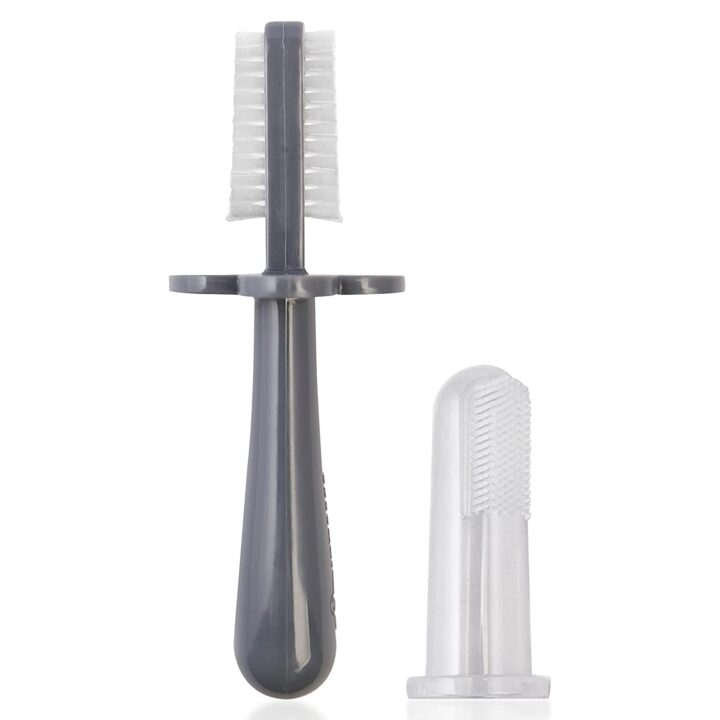

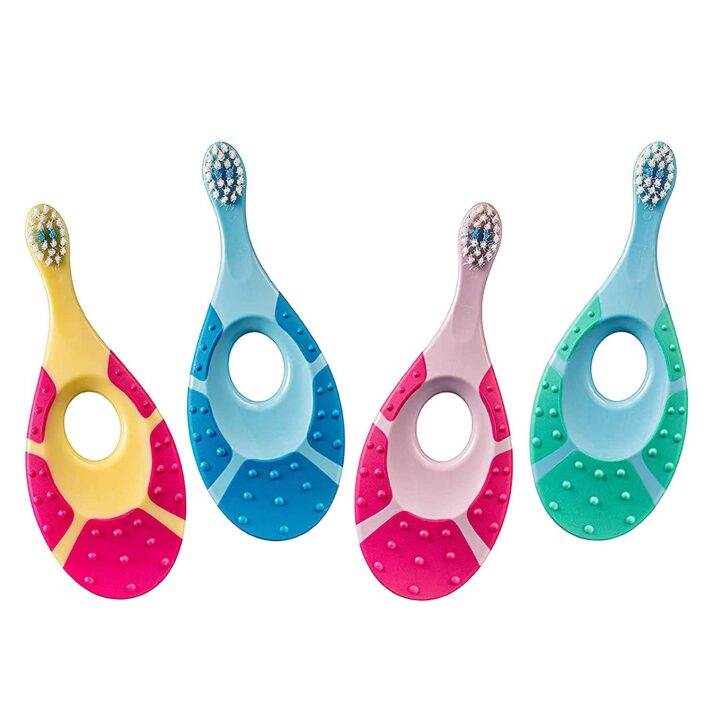
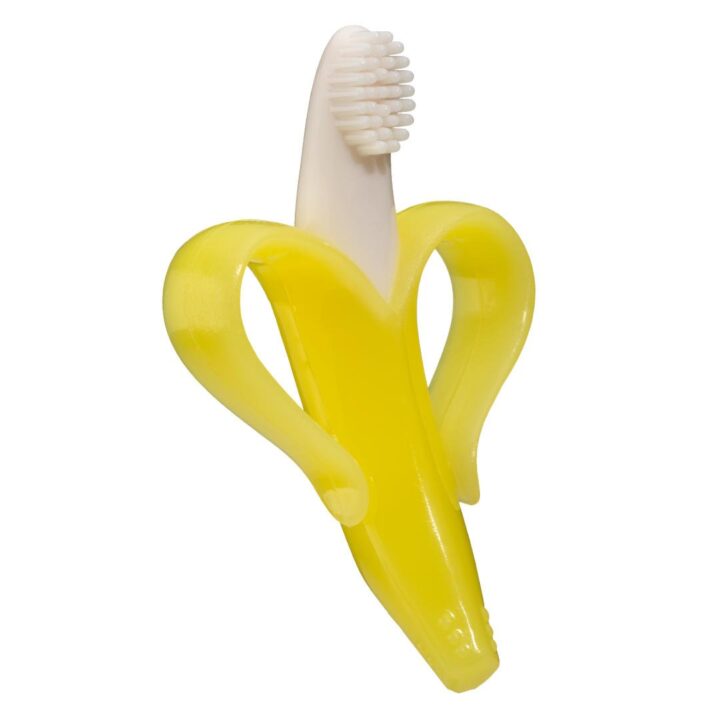
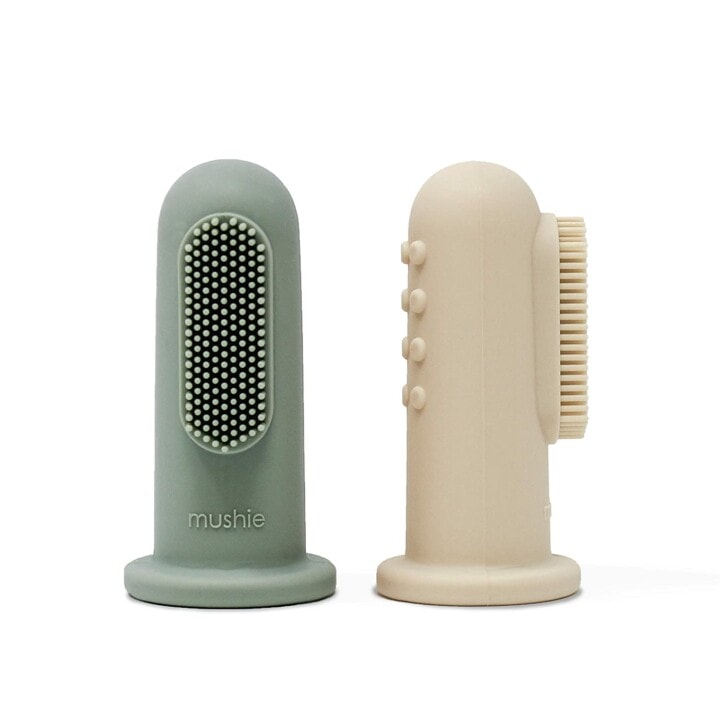
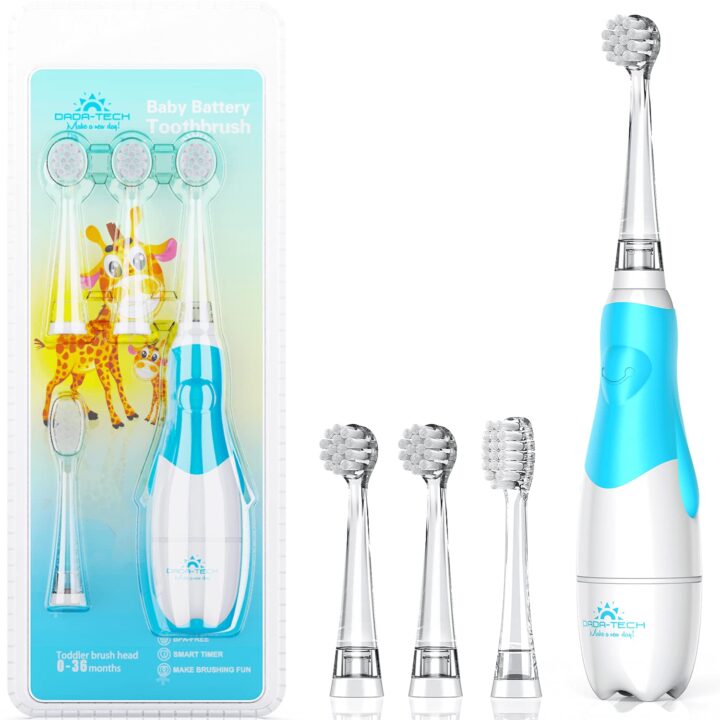
Our Favorite Baby and Toddler Toothbrushes
- grabease Double Sided Toothbrush
- Yellow Banana Infant Toothbrush
- Jordan Step 1 Baby Toothbrush
- Baby Electric Toothbrush
- mushie Baby Finger Toothbrush
- fridababy Training Toothbrush for Toddlers
Tips on How to Make Brushing Fun
- Model good brushing – let your toddler see you brushing your teeth often.
- Brush teeth in the bathroom – with busy toddlers, it’s easy to fall into the habit of chasing your little one. Set the expectation for brushing teeth in the bathroom. Use a towel or small mat on the floor for comfort as needed.
- Use a predictable pattern – brush in a consistent way to let your toddler know what to expect with each brushing. For example, brush left to right, and bottom to top.
- Talk about what you are doing – tell your toddler what’s going to happen. For example, “first we’re going to brush your bottom teeth, next we’re going to brush…”
- Make it fun – sing songs or count aloud in a silly voice. Create your own toothbrushing dance or watch a video of a favorite character brushing their teeth.
- Take turns – allow your toddler to have some turns with a toothbrush that they can hold. Adults can take turns brushing with a second toothbrush.
- Use the mirror – some toddlers do better when they can see where the toothbrush is going. Consider having a second adult hold a small mirror or let your toddler stand in front of a mirror to brush.
- Stay calm – your little one can sense if you’re starting to get frustrated. Try your best to relax and remember that building the foundation for good toothbrushing habits takes time.
Best Toothbrushes for Baby and Toddlers
Our favorite baby and toddler toothbrushes have soft silicone or nylon bristles to easily clean teeth and gums. We recommend starting with the Mushie Baby Finger Toothbrush or Banana Infant Toothbrush for infants and younger toddlers. Once your little one gets more teeth, you can switch to one of the soft nylon-bristled brushes for better coverage.

mushie Baby Finger Toothbrush
Help baby’s first brushing go smoothly and build good habits with these baby finger toothbrushes.
- Easily glides onto your fingertip so you can gently clean baby’s teeth without irritating gums
- Designed in Sweden and made of soft, food-grade silicone
- Bumps on the back assist with massaging sore gums, while bristles on the front clean teeth
- Best for ages 3-12 months

Yellow Banana Infant Toothbrush
Intended to be introduced when babies first begin teething and they instinctively want to stick everything in their mouths. The soft silicone bristles will gently massage sore teething gums when the brush is rubbed against them.
- Easy to hold teether toothbrush is made from high quality, food grade silicone
- Durable and easy to clean (dishwasher safe)
- Recommended for ages 3-12 months

grabease Double Sided Toothbrush
The unique doubled sided design on this baby toothbrush helps get both top and bottom teeth cleaned in no time!
- Tapered bristles allow your little one to achieve maximum teeth contact for a sparkling clean
- Super soft bristles are gentle on tender gums
- Innovative anti-choke barrier prevents gagging or choking
- Best for ages 12+ months

Jordan Step 1 Baby Toothbrush
This baby toothbrush is designed with extra soft bristles, a soft biting ring for gums, and a handle that suits both adults and baby’s hands.
- The short neck and unique teething ring help prevent gagging when brushing
- Colored bristles indicate the amount of fluoride toothpaste to be used
- Pack includes a set of 4 toothbrushes
- For ages 6 months to 2 years

fridababy Training Toothbrush for Toddlers
This toddler toothbrush includes triple angle, rounded bristles that gently clean all sides at once for thorough, yet efficient brushing.
- Soft silicone handle is easy for little and big hands to grip
- Suction cup on the bottom helps keep the brush from rolling off counters
- Bristles change from blue to white when it’s time to replace the brush
- For ages 18+ months

Baby Electric Toothbrush
This cute baby and toddler toothbrush has an LED light and gentle vibration designed to make brushing easy and fun.
- Soft nylon bristle and food grade silicone brush heads for a better brushing experience
- Equipped with a 2-minute smart timer and 30-second pulse reminders that instruct toddlers to brush the next quadrant of the mouth and help develop good brushing habits
- Includes toothbrush with 4 soft brush heads
- For ages 6 months to 3 years
